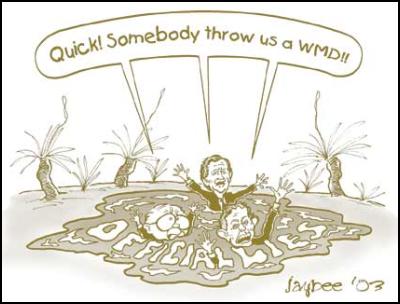Iraq: How Bush, Howard and Blair lied about WMD
Iraq: How Bush, Howard and Blair lied about WMD
By Rohan Pearce
Green Left Weekly

On May 30, US President George Bush told Polish television that the US military had found Iraq's “weapons of mass destruction” (WMD). Well, sort of. Remember the three (some media outlets have inaccurately reported two) trailers the US found. According to Bush, these trailers — or “mobile biological laboratories”, as he called them — are proof of US, British and Australian government claims that Iraq possessed an arsenal of banned weapons sufficient to justify their invasion of the country.
The CIA's May 28 report on the trailers describes them as “the strongest evidence to date that Iraq was hiding a biological warfare program”. However, when Iraqi officials at the al Kindi Research, Development and Engineering facility were shown photos of the trailers, “they claimed that the trailers were used to chemically produce hydrogen for artillery weather balloons”. The report admits: “Hydrogen production would be a plausible cover story for the mobile production units.”
The next day, the New York Times reported, after a briefing of journalists by US intelligence officials, that “the trailers' hardware presented no direct evidence of weapons use”. The “intelligence” officials “conceded that there were inconsistencies in the evidence and a lack of hard proof, like the presence of pathogens in trailer gear”, and that “they had discovered neither biological agents nor evidence that the equipment had ever been used to make germ weapons”.
In his January 28 State of the Union address, Bush claimed that Saddam Hussein's regime had up to “30,000 munitions capable of delivering chemical agents”, could produce “over 25,000 litres of anthrax” and “38,000 litres of botulinum toxin”, and may have produced “500 tons of sarin, mustard and VX nerve agent”.
The failure of the US occupation forces to find any evidence of this arsenal has led to infighting within the US “intelligence community” and prompted the US Congress to initiate an inquiry into the intelligence information used by the Bush administration to justify its invasion of Iraq.
The CIA's pre-war reports on Iraq's WMD are the subject of two inquiries, one conducted by the agency itself and the other by a group of former CIA analysts hand-picked by George Tenet, the agency's current director.
All of these inquiries are likely to find the CIA's reports were flawed. A February 20 report by CBS News correspondent Mark Philips reported that US “intelligence” given to UN weapons inspectors was considered “garbage after garbage after garbage” by the inspectors.
The inquiries, however, are unlikely to deliver the alternative conclusion — that the US, British and Australian governments set out to deliberately mislead people in order to build support for the invasion. Acknowledging this would have too high a political cost.
However, prior to the invasion, there was evidence that intelligence information was being manipulated by these governments. For example, the February 1 New York Times reported: “Some analysts at the Central Intelligence Agency have complained that senior administration officials have exaggerated the significance of some intelligence reports about Iraq, particularly about its possible links to terrorism, in order to strengthen their political argument for war.”
Even more damning was the suppression of the testimony of Iraqi General Hussein Kamal, who defected from the regime in 1995. Kamal's testimony was repeatedly cited as evidence of the extent of Iraq's WMD programs. For example, in a statement to the Australian parliament on February 4, attempting to justify support for an invasion of Iraq, Prime Minister John Howard cited Kamal's post-defection debriefing by UN weapons inspectors.
However, Howard didn't reveal that Kamal stated: “I ordered destruction of all chemical weapons. All weapons — biological, chemical, missile, nuclear were destroyed... nothing remained.”
It is now clear that Bush, Howard and British PM Tony Blair used a campaign of distortion, fabrication and outright lying to make their case for war. Remember these pre-war gems from government figures?
- “[Saddam Hussein's] weapons of mass destruction program is active, detailed and growing. The policy of containment is not working. The weapons of mass destruction program is not shut down; it is up and running now” — Tony Blair in the British parliamentary debate on Iraq, September 24.
- Iraq “possesses and produces chemical and biological weapons” and is “seeking nuclear weapons” — Bush during an address in Cincinnati, October 7.
- “Saddam Hussein still has chemical and biological weapons and is increasing his capabilities to make more. And he is moving ever closer to developing a nuclear weapon” — Bush in the same speech.
- “We know for a fact there are weapons there” — White House mouthpiece Ari Fleischer, January 9.
- “The Australian government knows that Iraq still has chemical and biological weapons and that Iraq wants to develop nuclear weapons” — Howard, February 4.
- “The facts and Iraq's behaviour show that Saddam Hussein and his regime are concealing their efforts to produce more weapons of mass destruction... Ladies and gentlemen, these are not assertions. These are facts corroborated by many sources, some of them sources of the intelligence services of other countries” — US Secretary of State Colin Powell's February 5 presentation at the UN.
The British government's dossier on Iraqi WMD, released on September 24, was a masterpiece of lies and distortions. The May 30 British Guardian revealed that many in the British intelligence services were opposed to publishing the dossier in its final form.
Among the claims made by the dossier, repeated ad nauseum by the CIA and the Pentagon, was that Iraq had tried to import uranium from Niger. The documents provided as evidence were not only fake, but were crudely done, including the misspelling of some words. But the documents were still considered evidence of an Iraqi nuclear weapon program until they were conclusively discredited by the International Atomic Energy Agency on March 7.
A BBC report on March 29 reported that a “senior British official” told the broadcaster the dossier was rewritten to make it “sexier”: “The classic example was the statement that weapons of mass destruction were ready for use within 45 minutes. That information was not in the original draft. It was included in the dossier against our wishes because it wasn't reliable.”
In a clear sign that the Bush administration's web of deception about Iraq's WMD is unravelling, on June 4, Douglas Feith, US undersecretary for defence policy, and William Luti, a deputy undersecretary of defence, held a press briefing in which they hit out at accusations of selective use of intelligence reports by the White House to make the case for war. “This suggestion that we said to [intelligence agents] `This is what we're looking for. Go find it', is precisely the inaccuracy that we are here to rebut”, Feith told journalists.
The administration's defensiveness was heightened after the uproar over comments made by US war secretary Donald Rumsfeld in a May 27 address to the Council on Foreign Relations in New York. Rumsfeld told the audience that the Pentagon didn't “know what happened” to Iraq's alleged arsenal of WMD, adding that Baghdad might have destroyed them all just before the US invasion.
(Rumsfeld's comments couldn't match those of Kenneth Adelman, a member of the Pentagon advisory board, for sheer audacity however. Adelman told the May 17 Washington Post: “It's just very strange [that WMD haven't been found]... There will certainly not be the quantity and proximity that we thought of before... [Saddam Hussein may have waged] a massive disinformation campaign to make the world think he was violating international norms, and he may not have been.”)
In mid-May there were indications that the “hunt” for WMD was winding down. A Washington Post report filed on May 18 quoted Shaun Anderson, a US Navy cryptologic and nuclear specialist who was part of US “weapons inspections” in Iraq: “Supposedly the weapons were a primary goal. I mean, the president said, `Go find the weapons of mass destruction'. But it has become a secondary mission.” But now the US has announced a new team, including British and Australian specialists, will be searching Iraq, an implicit acknowledgment that lame excuses, like Rumsfeld's, aren't credible.
The outrage provoked by Rumsfeld's comments, and the subsequent demands for public inquiries into the “evidence” of Iraq's WMD arsenal, make it even more likely that Washington will attempt to fabricate “proof” of WMD in Iraq.
On June 2, Blair responded to revelations about the doctoring of his government's dossier on Iraq by stating that he was “100% behind the evidence” that Iraq possessed WMD. “I simply ask the people, just have a little patience”, he told journalists, a possible indication that he expects a “discovery” of “evidence” in the coming weeks.
From Green Left Weekly, June
11, 2003.
Visit the Green Left Weekly home page.


 Gordon Campbell: On The Government’s Latest Ferries Scam
Gordon Campbell: On The Government’s Latest Ferries Scam Peter Dunne: Dunne's Weekly - While We're Breaking Up Monoliths, What About MBIE?
Peter Dunne: Dunne's Weekly - While We're Breaking Up Monoliths, What About MBIE? Adrian Maidment: Supermarket Signs
Adrian Maidment: Supermarket Signs Ian Powell: Revisiting Universalism
Ian Powell: Revisiting Universalism Martin LeFevre - Meditations: In A Global Society, There Is No Such Thing As “National Security”
Martin LeFevre - Meditations: In A Global Society, There Is No Such Thing As “National Security” Binoy Kampmark: Secrecy And Virtue Signalling - Another View Of Signalgate
Binoy Kampmark: Secrecy And Virtue Signalling - Another View Of Signalgate